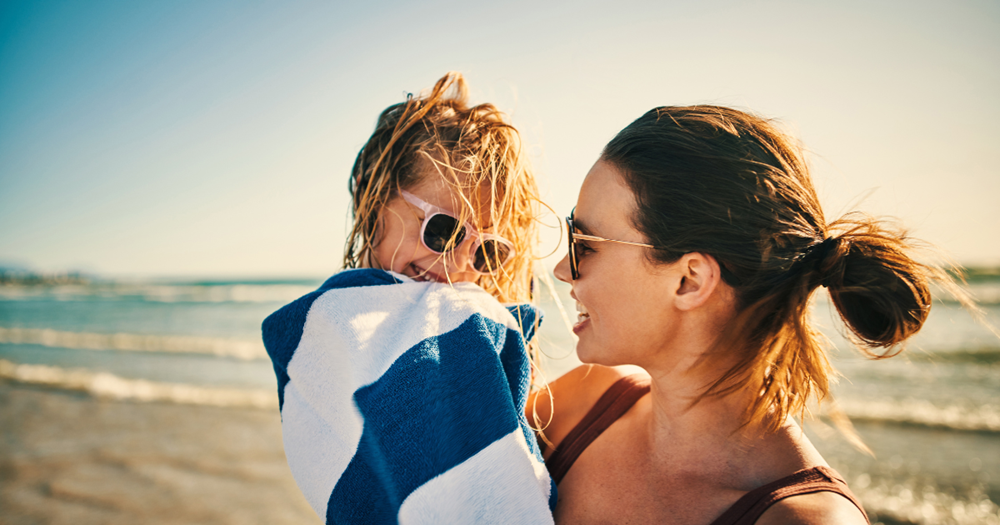We’re all ready for some fun in the sun, but it’s important to remember to stay safe and protect you skin during those warm summer days. Here's our sun-safety guide for you and your baby.

Use a sunshade on pushchairs and prams
Infants under 6 months should be kept in the shade and not be exposed to direct sunlight at all because their skin is too delicate and does not contain enough melanin yet; melanin is the pigment that gives hair and eyes their colour and provides some natural protection against the sun’s rays.
Older infants should also be kept out of the sun as much as possible, especially between 11am and 3pm when the sun is at its strongest. So, attaching a sunshade of some kind to your buggy or pram is generally a very good idea to protect your little one from sun exposure. But don’t drape baby's pram or pushchair with a piece of fabric – although this might provide shade, it can also create an unsafe, hot environment for baby, with little airflow.

Wear SPF on cloudy days, and in the shade, too.
Did you know that UV rays can get through clouds and fabric? So even if it’s cloudy out or you’re sitting in the shade under a parasol you still need to wear SPF to protect your skin against UV rays. This of course also goes for children.
One important thing to keep an eye on is the UV index; you can usually look up a daily UV index, which tells you the intensity of the sun’s UV radiation reaching the earth in your location. Whenever the UV index is above 3, the recommendation is to use sunscreen – including on cloudy days and in the shade.
Apply sunscreen 15 minutes before going outside – and reapply every 2 hours
To get the best protection from your sunscreen, you should apply it 15 minutes before going out. This way, the skin can absorb the sunscreen before being exposed to factors that reduce the protective effect. Those factors include sweating, bathing, the rubbing of towels and clothes and general activity.
It is also very important to use the right amount of sunscreen. The easiest way to remember the right amount of sunscreen is this: 1 handful for 1 body. So, one adult handful for one adult body, and the same goes for kids. To keep up your SPF protection all day long, reapplication is a must. A general rule of thumb is to reapply every 2 hours, but you should always consider your skin type, the time of day and if the skin is exposed to direct sunlight or in the shade.
Seek shade when the sun's UV rays are strongest between 11am-3pm
Around noon, when the sun is highest in the sky, the UV index is also at its peak; this is because the sun’s UV rays have a shorter distance to travel through Earth’s atmosphere than in the morning and afternoon. You should still wear sunscreen, as UV rays can penetrate parasols and trees, but staying in the shade around noon still offers some protection against sunburn and heatstroke. So, relax and enjoy a little siesta in the shade!
Remember to reapply after swimming and sweating
Don’t be fooled into thinking that a water-resistant sunscreen is strong enough to last all day without the need to reapply. With water-resistant sunscreen your child can play in the sea or paddling pool for 40 minutes without the protection wearing off, but after 40 minutes the protection is down to around 50%; this is why reapplication is key.
It’s also a great idea to use water-resistant sunscreen if you’ll be hiking, sightseeing or playing sports in the sun, but remember that sweating can also wear down the effectiveness of water-resistant sunscreen.

Wear a hat and cover exposed skin with clothes
We’ll say it again: UV rays can get through fabric, so you should always wear sunscreen. However, wearing a hat and covering exposed skin with clothes can help protect you, and especially your baby, even better.
Go for densely woven fabrics in natural materials such as cotton or viscose, which will help keep you and your baby cool and protected. When it comes to hats, again, go for something densely woven with a wide brim – avoid straw hats with large holes that will let the sun through. For babies, it is especially important to choose hats with wide brims to protect their eyes and the delicate skin on their neck and ears. Pro tip: if your baby does not agree that hats are a must, a sunhat with a strap might be your best option.
Too much sun exposure can cause sunburn and heatstroke, also known as sunstroke, and this is not something to take lightly. Babies and young children are especially at risk of heat exhaustion and heatstroke, as they can’t regulate their own body temperature as well as adults. Wearing a hat to block the sun’s UV rays from the top of your head can help regulate body temperature and prevent heat exhaustion and heatstroke, in both children and adults.
Not to mention the fact that even with a full head of hair you can actually get sunburned on your scalp if you go hatless – yes, really!
With these sun-safety tips, all that remains is for us to wish you a worry-free, happy summer! Remember: apply and reapply your sunscreen, stay protected and most importantly – get out there and enjoy!


